









Adjoint of a Matrix Calculator
This calculator will help you to calculate the Adjoint of a square matrix at a time with the steps shown.Related Calculators:Matrix Determinant CalculatorMatrix Inverse Calculator

Neetesh Kumar | January 28, 2025 (Updated)
Share this Page on:
![]()
![]()
![]()
![]()
![]()
- 1. Introduction to the Adjoint of a Matrix
- 2. What is the Formula used & conditions required?
- 3. How do I calculate the Adjoint of a Matrix?
- 4. Why choose our Adjoint of a Matrix Calculator?
- 5. A Video for explaining this concept
- 6. How to use this calculator?
- 7. Solved Examples on Adjoint of a Matrix.
- 8. Frequently Asked Questions (FAQs)
- 9. What are the real-life applications?
- 10. Conclusion
Matrices play a critical role in mathematics, engineering, and data science. The Adjoint of a Matrix is a powerful concept often used in finding inverses, solving linear equations, and performing advanced computations. Our Adjoint of a Matrix Calculator is designed to simplify these tasks, providing accurate results quickly and effortlessly. Whether you’re a student, researcher, or professional, this tool ensures precision and efficiency.
1. Introduction to the Adjoint of a Matrix
Imagine you're solving a puzzle, and one piece holds the key to the whole picture. That's similar to finding the adjoint of a matrix in mathematics. It's a simple but important concept, especially in linear algebra, with real-world applications in physics, engineering, and more. In this guide, we’ll explore the adjoint matrix, how to find it, and why it matters when using tools like our adjoint matrix calculator.
The adjoint of a matrix also called the adjugate matrix, is the transpose of the cofactor matrix of the original matrix. This operation is useful in finding the inverse of matrices, solving systems of linear equations, and other advanced mathematical operations. Our adjoint of a matrix calculator makes it easy to compute the adjoint of any matrix quickly and accurately.
2. What is the Formula used & conditions required?
The main condition for calculating the adjoint of a matrix is that the matrix must be square. This means the matrix must have the same number of rows and columns, such as a 2x2 matrix, 3x3 matrix, or 4x4 matrix. Non-square matrices do not have an adjoint, so our adjoint matrix calculator is designed to handle square matrices only.
Formula for Adjoint:
For a square matrix of size :
Where:
-
Cofactor: For an element , the cofactor is:
is the minor matrix obtained by removing the -th row and -th column from .
Conditions for Adjoint Calculation:
- The matrix must be square ().
- Determinants of minors must be computable.
For larger matrices, manual calculations can be tedious and prone to error, making a calculator essential.
Adjoint of a Matrix Formula
The adjoint of a square matrix of order , can be defined as the transpose of the cofactor matrix.
Consider the matrix with the elements , and their cofactor elements are respectively.
Then, the adjoint of the matrix formula is as follows:
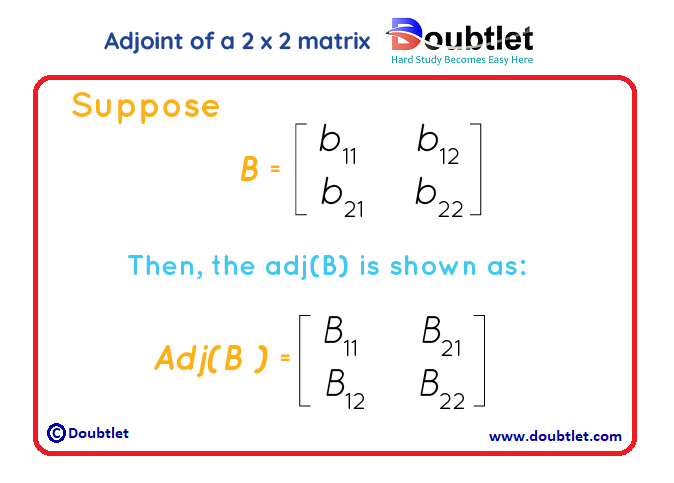
Adjoint Of a Matrix
Let be the matrix and is given by:
Then, the adjoint of this matrix is:
Here,
Alternatively, the adj A can also be calculated by interchanging and and by changing signs of and . This can be shown as:
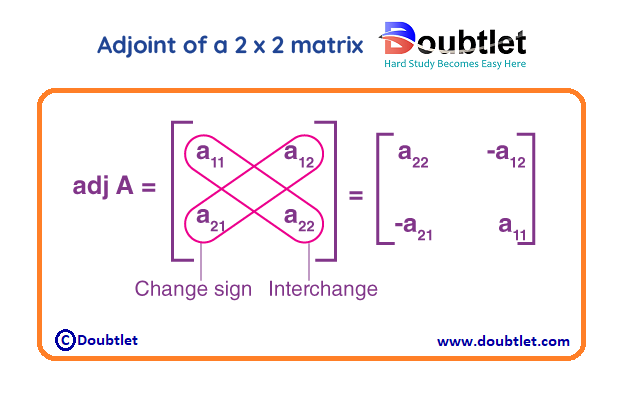
3. How do I calculate the Adjoint of a given matrix?
Begin with a square matrix, denoted as matrix A.
For each element in matrix A, create a new matrix by excluding the row and column that contain the element.
Calculate the of each smaller matrix. These determinants are known as cofactors.
Form a new matrix, called the cofactor matrix, using the of each element of matrix A.
Transpose of the cofactor matrix by switching its rows and columns. The resulting matrix is the adjoint of the matrix A.
Using our matrix adjoint calculator, you can automate these steps and receive the solution within seconds, whether a 2x2 matrix, 3x3 matrix, or even a more complex 4x4 matrix.
To manually calculate the adjoint:
- Find Minors: For each element , calculate the determinant of the minor matrix .
- Determine Cofactors: Multiply each minor by .
- Form the Cofactor Matrix: Arrange the cofactors into a matrix.
- Transpose the Cofactor Matrix: Swap rows and columns to obtain the adjoint.
Example: Find the Adjoint of a Matrix
Find the adjoint of the matrix:
Solution:
1. Compute the Cofactor Matrix:
For each element , calculate the cofactor using minors:
Thus, the cofactor matrix is:
Cofactor Matrix:
2. Take the Transpose:
Final Answer:
Our calculator automates this process, ensuring accuracy and efficiency.
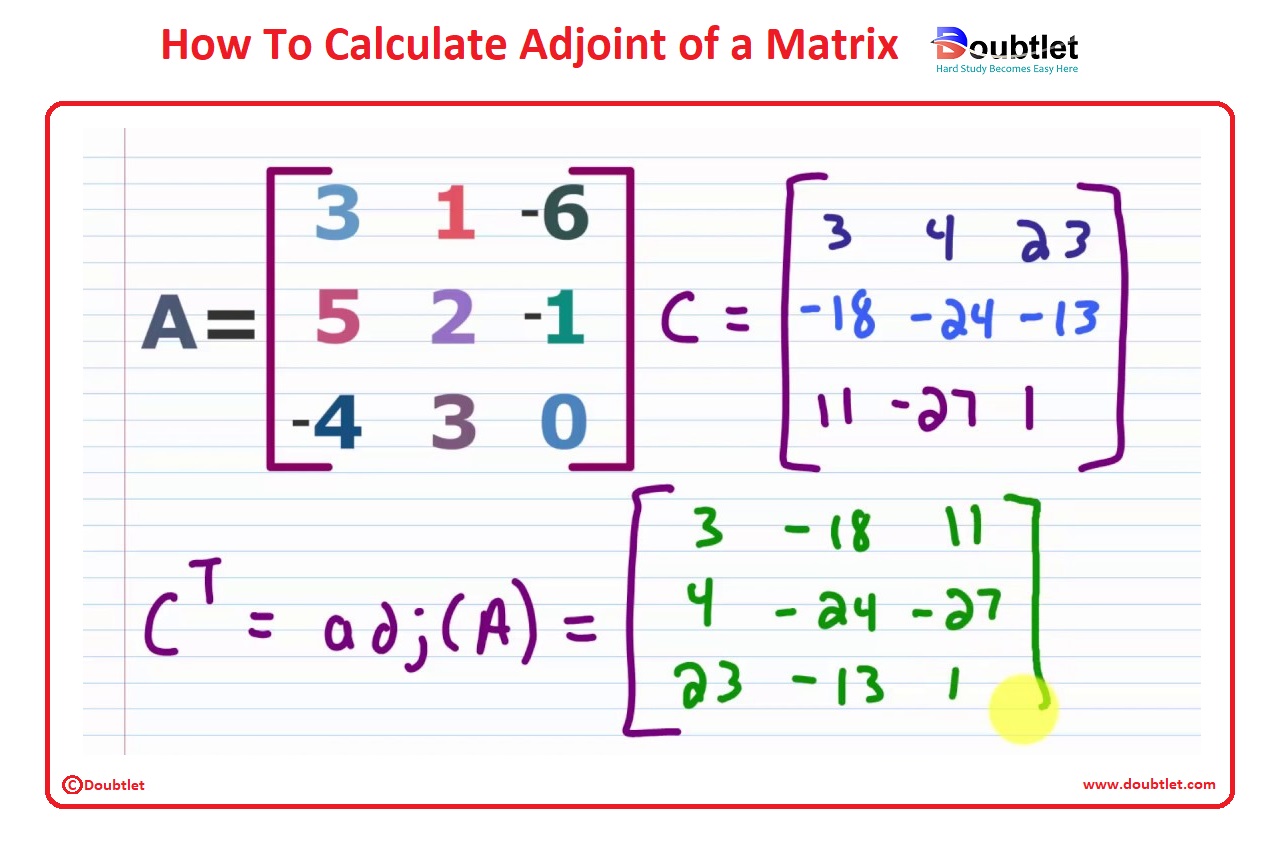
4. Why choose our Adjoint of a Matrix Calculator?
Our adjoint matrix calculator offers a user-friendly experience. Input your square matrix, and the calculator will compute the adjoint matrix in seconds. This tool simplifies the process, whether you need to find the adjoint of a 2x2 matrix or a 3x3 matrix.
Calculating the adjoint of a matrix manually can be time-consuming, especially for larger matrices. Our matrix adjugate calculator automates this process, allowing you to focus on more complex problems.
The adjoint matrix formula is calculated based on established mathematical principles, ensuring accurate and error-free results. No need to worry about manual mistakes with our matrix adjoint calculator.
Our calculator supports various matrix sizes, including 2x2 matrices, 3x3 matrices, and 4x4 matrices. Whether you're solving for cofactor matrices or finding the adjugate of a matrix, this tool can handle all your matrix needs.
In addition to our adjoint of a matrix calculator, we offer other useful tools like matrix cofactor calculators, inverse matrix calculators, and more. These resources help you master linear algebra, physics, and engineering topics.
5. A detailed video based on the concept of Adjoint of a Matrix.
This video explains how to find the adjoint of a matrix step-by-step, whether you are dealing with a 2x2 matrix, 3x3 matrix, or higher-order matrix.
6. How to use this calculator
To use our adjoint of a matrix calculator, simply:
- Input the elements of your matrix into the calculator.
- Click on the Calculate button.
- The adjoint matrix will be displayed, complete with step-by-step explanations. You can easily access, download, and share the solution.
7. Solved Examples
Let's calculate the Adjoint of the given matrix A = .
The Adjoint matrix of the above-given matrix can be calculated by taking the transpose of the matrix of cofactors, i.e.
C =
now Adj(A) = =
Let's calculate the Adjoint of the given matrix .
The Adjoint matrix of the above-given matrix can be calculated by taking the transpose of the matrix of cofactors, i.e.
C =
now Adj(A) = = 8) = 13.
8. Frequently Asked Questions (FAQs)
What's a square matrix?
A square matrix has an equal number of rows and columns, like 2x2, 3x3, or 4x4 matrices.
Can I find the adjoint of any matrix?
No, the matrix must be square to have an adjoint. Only square matrices have adjoints.
Why is the adjoint useful?
It helps solve tricky equations and is super important in physics and engineering.
What are the cofactors of a matrix?
Cofactors are determinants of smaller matrices formed by removing the row and column of an element. They are used to calculate the adjugate matrix.
Can the adjoint be negative?
Sure, the numbers in the adjoint can be positive, negative, or even zero.
9. What are the Real-life applications?
Matrix transposition has numerous real-life applications, including:
In data science, it is essential for reshaping data, making it suitable for various analyses and algorithms.
It is used to manipulate and transform images, particularly in computer graphics and image editing software.
It is a crucial operation in solving systems of linear equations and finding solutions to problems in physics and engineering.
In quantum mechanics, the complex conjugate Adjoint of a matrix plays a crucial role in representing quantum states and operators.
10. Conclusion
Finding the adjoint of a matrix may seem challenging, but with tools like our adjoint matrix calculator, it's much simpler. From solving 2x2 matrices to complex 4x4 matrices, understanding this concept is crucial for tackling problems in physics, engineering, and advanced mathematics. Use our calculator to save time, improve accuracy, and master matrix operations effortlessly.
If you have any suggestions regarding the improvement of the content of this page, please write to me at My Official Email Address: doubt@doubtlet.com
Are you Stuck on homework, assignments, projects, quizzes, labs, midterms, or exams?
To get connected to our tutors in real-time. Sign up and get registered with us.
Comments(0)










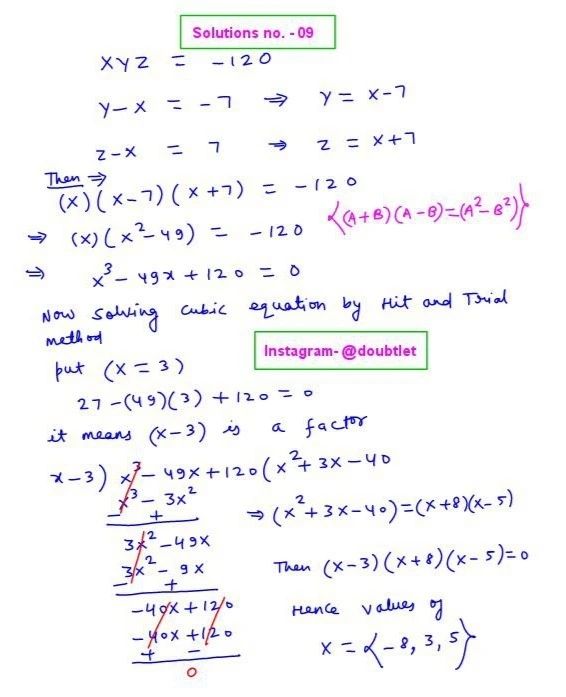
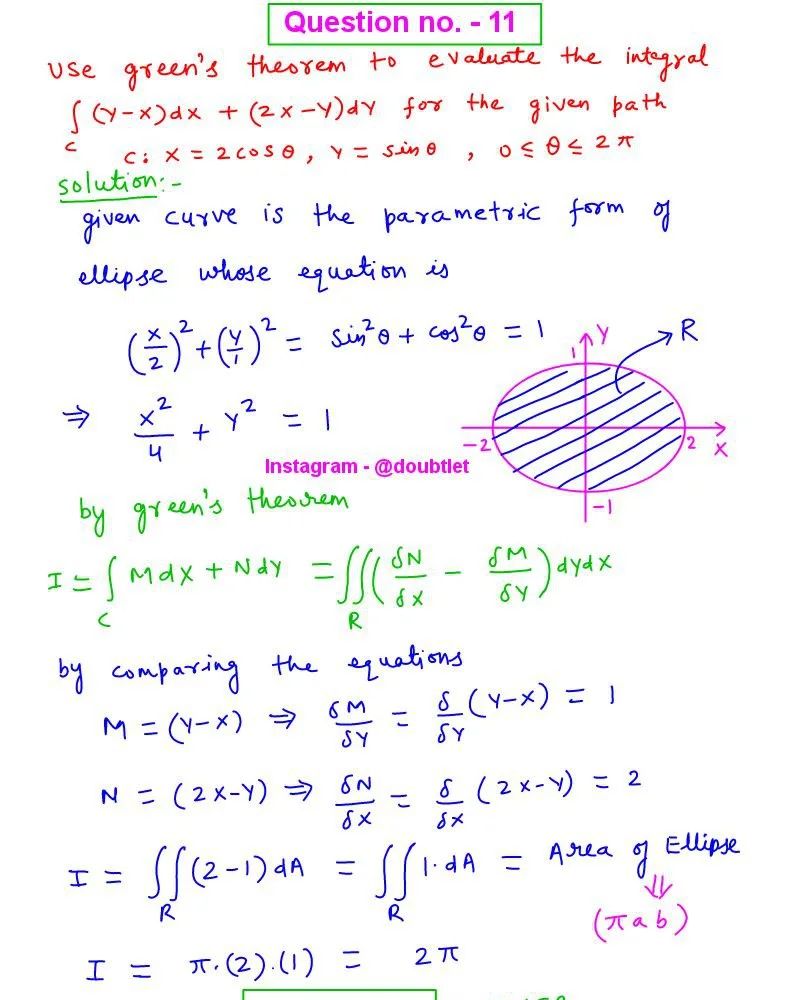

Leave a comment